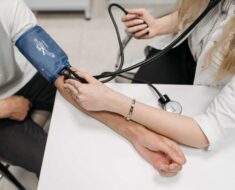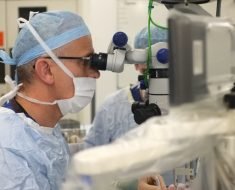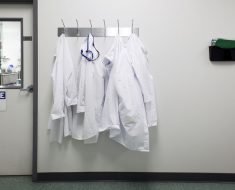
Preventive health care—such as cancer screening—is a critical tool in the early detection of disease. Missed screening can result in a missed diagnosis, delayed treatment and reduced chances of survival.
But the medical system is poorly equipped to meet the needs of gender-diverse patients.
Around 1.64 million people in the U.S. identify as transgender, nonbinary or gender diverse—people whose gender identity differs from the sex they were assigned at birth.
This adds up to 1.3 million or 0.5% of U.S. adults, all of whom are more likely to encounter implicit, or unconscious, biases when they seek medical care compared with their cisgender counterparts—those whose gender identity aligns with the sex they were assigned at birth.
I am a primary care doctor in Appalachia, as well as a medical educator who studies how to improve the instruction of future health care providers. I work hard every day to improve the health of the underserved.
Primary care doctors devote much of their lives to preventive medicine—the art of stopping disease before it starts. Cancer screening consumes much of my life.
So I’m concerned about the barriers to preventive care for patients who are transgender, including consistent access to adequate cancer screening.
The problems with the binary model
Health care spaces and providers often focus on “men’s health” or “women’s health” specifically. Intake forms may have no option for declaring a gender identity separate from the sex assigned at birth. Health screening and insurance policies for diseases like cancer tend to remain geared to a flawed binary male-female model.
Gender-diverse patients often find themselves teaching their primary care doctors how to provide them with competent care, because many medical students get little training on providing gender-affirming care.
As a result, 1 out of 3 gender-diverse adults do not seek preventive care, according to a report by the National Center for Transgender Equality—or they are not offered these services at all—when they see a health care provider. Even more alarming, 19% of transgender folks report that they’ve been refused care altogether.
This may contribute to higher rates of tobacco use, obesity, alcohol use and other cancer risk factors in gender-diverse people.
Cancer care challenges
Research to date shows that transgender adults over age 45 are screened for colon cancer at a lower rate than cisgender patients. They are also more likely to be diagnosed at later stages of lung cancer. This can be devastating, because finding lung cancer before it spreads can literally mean the difference between life and death.
The University of California, San Francisco, one of the few places that has protocols for the care of transgender patients, recommends that transgender women who are older than 50 and have been taking a feminizing hormone for five years begin getting screened for breast cancer. However, according to a recent Canadian study, only about 1 in 3 transgender women who are eligible for breast cancer screening receive mammograms, compared with 2 in 3 eligible cisgender women.
In a 2021 study, researchers found that transgender patients with non-Hodgkin lymphoma, prostate cancer or bladder cancer had roughly twice the death rate of their cisgender counterparts. Since the researchers were able to firmly identify only 589 transgender individuals out of nearly 11.8 million records, they could not accurately compare rates for other types of cancer.
Since 2017, the American Society of Clinical Oncology has recommended including data about patients’ sexual and gender minority status in cancer registries and clinical trials. However, in 2022 the society found that only half of oncology care providers are routinely collecting gender identity information. So it’s clear that there’s still a lot to learn about the barriers to inclusive cancer care.
https://youtube.com/watch?v=Ee4fyqk997s%3Fcolor%3Dwhite
Lack of training in both medical school and residencies—intensive training stints where new doctors hone their skills—perpetuates these disparities.
Bias in medical school
Medical education is plagued by biases that reflect society’s stereotypes and prejudices. Further, researchers have found that students can unconsciously absorb biases or stereotypes encountered in their medical education.
And just 26% of doctors directing family medicine clerkships—courses in which medical students start working and interacting with real patients—say they feel comfortable teaching transgender health care.
So the Association of American Medical Colleges has called for emphasizing at all levels of training the health of people who are lesbian, gay, bisexual, transgender, queer or questioning and other identities—known as LGBTQ+. The association recommends that schools take a “layered” approach that integrates education on gender-affirming health care across their curricula. This can include incorporating LGTBQ+ health in early coursework, using practice patients in simulation, and creating opportunities to care for patients with lived experience.
Many medical schools still fail to integrate gender-affirming care throughout the curriculum, though. Instead, medical schools often append it to the existing curriculum—offering dedicated lectures or small-group activities that address LGBTQ+ health. Medical schools overall are providing a median of only five hours of instruction on gender-affirming health care practices.
Health insurance obstacles
In 2015, the Centers for Medicare and Medicaid Services clarified that preventive care services are available under the Affordable Care Act, regardless of gender identity.
However, the main organizations guiding providers and insurance coverage regarding breast, cervical and prostate cancer screening continue to use an approach based on the ingrained binary male-female model approach.
For example, the U.S. Preventive Services Task Force still gears its recommendations for breast and cervical cancer screenings toward cisgender women, with little guidance on how to apply them to transgender patients.
This is driven in part by a lack of data on how to best screen transgender patients for cancer.
Insurance coverage and companies also create hurdles. Gender-diverse patients are more likely to be uninsured or underinsured—making it much harder for them to access preventive medical care. A gender identity mismatch in an electronic medical record can trigger a denial for a cancer screening.
Momentum for change
Fortunately, the medical field is recognizing that gender-diverse patients have unique health care needs.
Since 2017, the American College of Obstetricians and Gynecologists has published recommendations for health care providers on making their practices open and inclusive for all individuals. Training all staff and creating an open office space without a gendered approach is a key recommendation.
Now over 20 medical organizations give similar guidance, with hopes of increasing inclusion through the health care system.
Another encouraging sign is that some medical schools are integrating gender-affirming care into their coursework. The University of Louisville in Kentucky reports that it now offers 50 hours of LGBTQ+-specific topics. And a faculty-student team at the Boston University School of Medicine has developed a tool to help medical schools assess and improve how they educate students to provide sexual and gender-minority health care.
I’m hopeful that the next generation of health care providers will be a force for change at their institutions; in my experience, incoming medical students are more aware of health disparities than their older generations of educators.
Provided by
The Conversation
This article is republished from The Conversation under a Creative Commons license. Read the original article.
Source: Read Full Article





